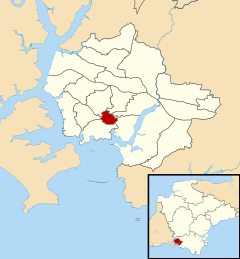Drake (ward)
| Drake | |
|---|---|
| Ward | |

Drake Circus and the Roland Levinsky Building, which is part of the university.
|
|
 Drake shown within Plymouth and Devon |
|
| Coordinates (North Hill Church): 50°22′41.74″N 4°8′6.83″W / 50.3782611°N 4.1352306°WCoordinates: 50°22′41.74″N 4°8′6.83″W / 50.3782611°N 4.1352306°W | |
| Area | |
| • Total | 0.849 km2 (0.328 sq mi) |
| Population (2001) | |
| • Total | 8,831 |
| • Density | 10,000/km2 (27,000/sq mi) |
| Postcode | PL4 |
Drake is an election ward within Plymouth, Devon, England. One of the main roads from the city to and Dartmoor runs through the ward. In the past it played an important role in the supply of water to Plymouth, and it was the location of both a fatal bomb explosion and a large unexploded bomb during the Plymouth Blitz. The University of Plymouth has its main campus in this ward and the large student population has led to part of it being designated as one of the four areas subject to Designated Public Places Orders in the city. It is also the location of the city's main railway station, museum and public library.
In 1591, Drake's Leat first supplied water to Plymouth. Its route came through what is now Drake ward, but was at the time outside the town walls. When Sir Francis Drake constructed the leat he ensured that he held the rights to build mills on it. At least two of those mills were within this ward; the site of the higher one was converted to a reservoir in the late 19th century and is now known as Drake's Place Reservoirs.
In common with much of the city, many buildings in this ward were destroyed or damaged during the Plymouth Blitz of World War II. In one fatal incident, on the night of 22 April 1941, a bomb fell on the Portland Square air-raid shelter killing over 70 civilians, including a mother and her six children. Human remains were found in the tops of trees, as a result of the bomb blast. In 2006 part of the remains of the shelter were rediscovered on the university campus, and an appeal was made to raise money for a public sculpture to honour those who lost their lives. This is now the Portland Square memorial.
Another, non-fatal, incident occurred during a short sharp air raid on 14 June 1943. A 1,000 kg bomb came through the roof of the then main police headquarters in Greenbank Road, on the eastern edge of the ward. The bomb did not explode and came to rest on the first floor landing outside the court rooms and above the cells and the control room, both of which were occupied. There were also many police in the building at the time. The headquarters had to be evacuated for several days until this bomb and another that had landed in the adjoining building were made safe and removed.
...
Wikipedia
